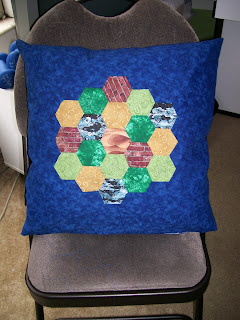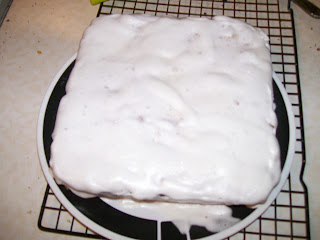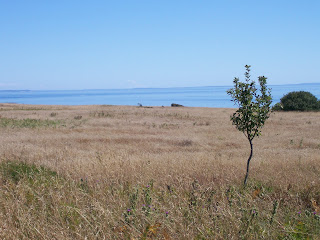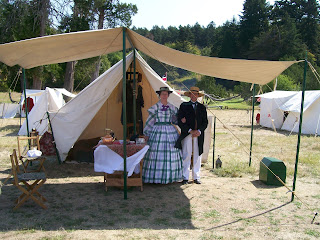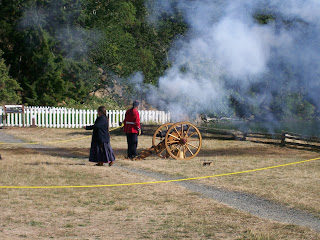Today I dressed 16th century for the first time, in order to accompany
Elise to the local Ren Faire. Though originally aiming for the early-mid century (late in the reign Henry VIII), I ended up making a few basics from
The Tudor Tailor. It turned out that Elizabeth I was holding court, so the lack of specificity served me well.
 |
| Smock and kirtle. |
In addition to the
smock previously described, I made a side-lacing kirtle with gored skirt. The material is a brown linen-cotton blend (mea culpa) that I picked up at Hancock's a few years back. The skirt is all hand-sewn, as are the eyelets and bodice finishing, though I did use a machine on some of the internal bodice seams to save time. The bodice is lined with linen, and its front is interlined with canvas and more linen. After wearing it once, I determined that some boning is needed along the eyelets to keep them from collapsing in an unsightly manner. Otherwise, I was pleased to find that the canvas provided sufficient support.
The head covering I chose was the headrail, a square yard of hemmed linen; it worked incredibly well to keep my hair up and out of the way. The hairstyle was two braids crossed around and over the head; the rail was folded and pinned over the hair.
The Tudor Tailor explains how to do this, with illustrations. What surprised me most was that the rail--with one hairpin, two straight pins, and two linen strips--kept all of my hair up for twelve hours without needing adjustment.
Rounding out the ensemble, though un-pictured, are a pair of knee-length linen bias-cut hose (blue, of course), a small drawstring purse worn inside the kirtle, and a rough pair of leather turn-shoes. I consulted Grew, de Neergaard, and Mitford's
Shoes and Pattens for background on the latter, but as it's latest finds date from c.1450, it's at least a half-century out of date for this project. Pratt and Woolley's
Shoes (VAM) was more helpful, as it includes two shoes from the 16th century, though both are men's. It's noted that women's shoes follow similar, though less ostentatious, lines. Even with the leather soles glued on to the sewn cloth ones (yes, that's why they're no pictures, it was rushed and very amateurish), the shoes held up all day, and even resisted the rain until the tail end of the event. I didn't finish my garters in time, but two strips of torn linen tied in garter knots sufficed.
This outfit is still very much a work in progress. Before it's next outing, I intend to add sleeves to the kirtle (laced at the shoulder), bones the side opening, and more eyelets. There will also be proper shoes, an apron, and hopefully a gown to over the kirtle. I'm thinking green...







